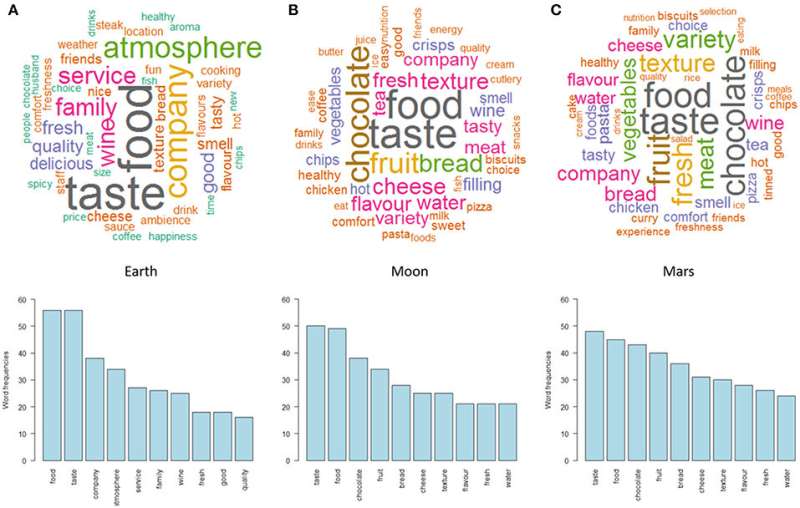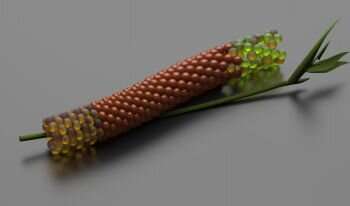Word clouds (upper panel) representing the most frequently selected words and corresponding 10 most frequent words (lower panel) for Earth (A), The Moon (B), and Mars (C). Credit: Frontiers in Computer Science (2019). DOI: 10.3389/fcomp.2019.00003
For the new space race, astronauts and space tourists will want to eat a little better than the corn beef sandwiches, applesauce and high-calorie cubes of protein, fat and sugar consumed by NASA scientists in the 1960s.
But how to provide genuinely exciting and mouth-watering food that can also stir up happy memories of a home millions of miles away in the confines of zero gravity and restricted room of a space shuttle?
That's the challenge four academics led by Professor Marianna Obrist, Professor of Multisensory Experiences at the University of Sussex, have attempted to meet in their paper "Space Food Experiences: Designing Passenger's Eating Experiences for Future Space Travel Scenarios."
The paper develops three design concepts that integrate and tackle the functional, sensorial, emotional, social, and environmental/atmospheric aspects of eating experiences in space:
- Spice Bomb Mixing—An "emotional" cleanser combating the diminished flavour perception in space caused by stuffiness in the nose. Solid spices and ingredients are not commonly used in space food because of the risk of them floating away. But the team propose a mixing pod which would dissolve into the food—injecting a meal with flavour and texture.
- Flavour Journey 3-D Printer—An astronaut or tourist could order a flavour profile from family, friends, or chefs which would be recreated through a food printer within the space shuttle. Potentially an astronaut could enjoy a "bar" that integrates several courses in one print.
- Earth Memory Bites—Small bites that contain distinct flavours representing different regions, cultures, or specific experiences and then embedded in a specific dining environment through projection mapping and VR for a shared dining experience with friends and family. Music, visual projections, atmospheric light, temperature, and humidity could all be used to recreate distinctive Earth atmospheres.
A 3-D printed bar containing all of a space traveller's favourite flavours. Credit: University of Sussex
The paper also discusses how different lighting (e.g., red) and sonic (e.g., high pitch tunes) conditions can modulate how people experience and enjoy different food and drinks as well as how to bring in elements of surprise, semantic instability and ambiguity that can elicit moments of wonder from space diners who will have to ward off feelings of boredom and homesickness on flights lasting up to 14 months.
The ideas have been developed following an online survey of what potential astrotourists would want from their eating experience and refined following feedback from experts with experience working within governmental space agencies and private space companies.
Professor Obrist, head of the Sussex Computer Human Interaction (SCHI) Lab at the University of Sussex, said: "Designing human-food interactions in space is not a trivial task. Before astronauts eat in space, they need to undergo dedicated training on Earth, and multiple challenges associated with nutrition, production, conservation, and transportation, among others, have to be considered.
"Given the increasing possibilities of short and long-term space travel to the Moon and Mars, it is essential not only to design nutritious foods but also to make eating an enjoyable experience. To date most research on space food design has emphasized the functional and nutritional aspects of food. There have been no systematic studies that focus on the human experience of eating in space."
Carlos Velasco, Associate Professor at the BI Norwegian Business School, said: "We have aimed to capitalize on recent technological advances around digital fabrication, 3-D food printing technology, and virtual and augmented reality to enable the design and integration of multisensory eating experiences.
"Since the early days of space exploration, space programs have spurred on a range of innovation around space food systems such as the microwave ovens or ready meals which might never have been developed otherwise. The innovations of space food technology could become the everyday eating experiences for the world in the not too distant future."
More information: Marianna Obrist et al. Space Food Experiences: Designing Passenger's Eating Experiences for Future Space Travel Scenarios, Frontiers in Computer Science (2019). DOI: 10.3389/fcomp.2019.00003
Provided by University of Sussex






















